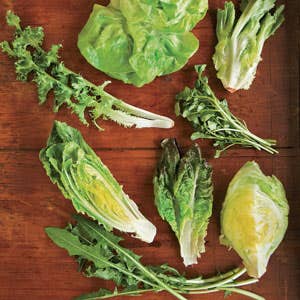
A Guide To Greens
1. CURLY ENDIVE
Curly endive, a member of the Cichorium endivia group, is easy to confuse with more delicate frisee (they're the same plant; frisee is cultivated by different techniques). Both have long, spindly leaves with frayed ends. Growers achieve the mix of pale inner leaves and darker green tips and outer leaves by tying the tops of the heads closed as they mature. The slightly bitter leaves of curly endive taste best when drizzled with a bold dressing like ranch or tempered with a hot bacon dressing.
2. BUTTERHEAD LETTUCE
One of the five main types of leafy greens of the Lactuca sativa, or lettuce, species (the others are loose-leaf, crisphead, batavian, and romaine), butterhead lettuces include boston and bibb (named after a 19th-century Kentucky vegetable grower) and can be identified by their supple, rounded leaves. Heirloom varieties include grandpa admire's; a reddish French lettuce called merveille des quatre saisons; and one of the oldest, tennis ball, a favorite of Thomas Jefferson's. The sweet, delicate flavor of these lettuces is best brought out when they're tossed sparingly with a tart dressing or a vinaigrette.
3. ESCAROLE
Cultivated in ancient Egypt, this member of the endive family has been grown in the U.S. since the early 19th century. The splayed-leaf heads have broad, ruffled leaves that range in color from pale yellow to dark green; the most prized heads have a larger proportion of pale, inner leaves. Also called batavian or broad-leaf endive, pleasantly bitter escarole is good in salads with apples, toasted nuts, and blue cheese or with a creamy mustard dressing.
4. WATERCRESS
In the fourth century B.C., Greek soldiers ate this tender green as a tonic, and the Romans believed it could cure baldness. Part of the plant's Latin name, nasturtium, translates as nose twister, a reference to its pungency (it's part of the mustard family). Succulent with a peppery bite when young, watercress can become unpleasantly hot and tough as it matures; if you can, taste before buying. Use watercress (including the flavorful stems) in salads—pairing it with ingredients both salty and sweet—or serve it unadorned alongside grilled meats and fish.
5. ICEBERG LETTUCE
Iceberg, a type of crisphead lettuce, earned its name in the 1920s; it was the first commercially grown lettuce durable enough to be packed in ice and shipped long distances. The satisfying crunch and wilt-resistant character of these tightly compacted heads more than make up for iceberg's understated flavor. Cultivars such as ice queen, webb's wonderful, and red iceberg have similar characteristics but more flavor. Serve as a wedge, napped with thousand island or another thick, creamy dressing. Iceberg is also good in chopped or shredded salads.
6. RED LEAF LETTUCE
This loose-leaf lettuce is an example of what some gardeners call cut-and-come-again lettuces because the leaves can be harvested multiple times in a single season. The leaves range in appearance from bronze to maroon, with smooth, crenellated, or ruffled edges. Names to look for are red sails, red oak leaf, red salad bowl, and the frilly variety lolla rossa. At its prime, red leaf is tender, with a mellow, grassy flavor; toss this colorful lettuce with herbs and simple vinaigrettes.
7. DANDELION GREENS
Wild dandelion (Taraxicum officinale) grows almost everywhere in the world. Foragers collect it in the early spring when the leaves are very tender. The name comes from the French dent de lion (lion's tooth), a reference to the jagged shape of the foliage—though today the French call dandelion pissenlit. With its pungent, earthy flavor, dandelion adds good contrast to a mixed salad when used in small amounts. Tangy cheese, such as goat or blue, and roasted-nut oils pair nicely with the vivid-tasting dandelion.
8. ROMAINE LETTUCE
With its crunchy, thick ribs and long, slender leaves, romaine lettuce is prized for its texture and mild, celery-like flavor. Romaine was originally called (and sometimes still is) cos, from the Arabic word for lettuce. Red romaine, paris white, lettuce balloon, and crisp mint (so named because of its serrated leaves, which resemble spearmint's) are varieties of romaine with similar attributes. Essential for a proper caesar, romaine's sturdy leaves welcome any creamy or pungent dressing.
Keep Reading
Continue to Next Story










